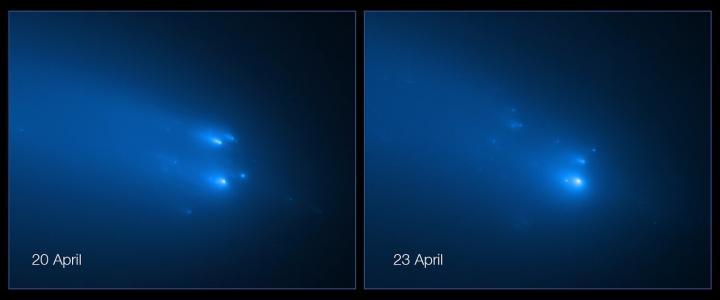
Credit: NASA, ESA, D. Jewitt (UCLA), Q. Ye (University of Maryland)
The NASA/ESA Hubble Space Telescope has provided astronomers with the sharpest view yet of the breakup of Comet C/2019 Y4 (ATLAS). The telescope resolved roughly 30 fragments of the fragile comet on 20 April and 25 pieces on 23 April.
The comet was first discovered in December 2019 by the ATLAS (Asteroid Terrestrial-impact Last Alert System) robotic astronomical survey system in Hawai?i, USA. It brightened quickly until mid-March, and some astronomers initially anticipated that it might be visible to the naked eye in May to become one of the most spectacular comets seen in the last two decades. However, the comet abruptly began to get dimmer, leading astronomers to speculate that the icy core may be fragmenting, or even disintegrating. ATLAS’s fragmentation was confirmed by amateur astronomer Jose de Queiroz, who photographed around three pieces of the comet on 11 April.
The Hubble Space Telescope’s new observations of the comet’s breakup on 20 and 23 April reveal that the broken fragments are all enveloped in a sunlight-swept tail of cometary dust. These images provide further evidence that comet fragmentation is probably common and might even be the dominant mechanism by which the solid, icy nuclei of comets die.
“Their appearance changes substantially between the two days, so much so that it’s quite difficult to connect the dots,” said David Jewitt of UCLA, leader of one of two teams who imaged the doomed comet with Hubble. “I don’t know whether this is because the individual pieces are flashing on and off as they reflect sunlight, acting like twinkling lights on a Christmas tree, or because different fragments appear on different days.”
“This is really exciting — both because such events are super cool to watch and because they do not happen very often. Most comets that fragment are too dim to see. Events at such scale only happen once or twice a decade,” said the leader of the second Hubble observing team, Quanzhi Ye, of the University of Maryland.
Because comet fragmentation happens quickly and unpredictably, reliable observations are rare. Therefore, astronomers remain largely uncertain about the cause of fragmentation. One suggestion is that the original nucleus spins itself into pieces because of the jet action of outgassing from sublimating ices. As this venting is likely not evenly dispersed across the comet, it enhances the breakup. “Further analysis of the Hubble data might be able to show whether or not this mechanism is responsible,” said Jewitt. “Regardless, it’s quite special to get a look with Hubble at this dying comet.”
Hubble’s crisp images may yield new clues to the breakup. The telescope has distinguished pieces as small as the size of a house. Before the breakup, the entire nucleus may have been no more than the length of two football fields.
The disintegrating ATLAS comet is currently located inside the orbit of Mars, at a distance of approximately 145 million kilometres from Earth when the latest Hubble observations were taken. The comet will make its closest approach to Earth on 23 May at a distance of approximately 115 million kilometres, and eight days later it will skirt within 37 million kilometres of the Sun.
###
More information
The Hubble Space Telescope is a project of international cooperation between ESA and NASA.
These observations were made during GO/DD proposal 16111 (https:/
Image Credit: NASA, ESA, D. Jewitt (UCLA), Quanzhi Ye (University of Maryland)
Links
Images of Hubble – https:/
HubbleSite release – https:/
Contacts
Quanzhi Ye
University of Maryland
Maryland, USA
Email: [email protected]
David Jewitt
UCLA
Los Angeles, California, USA
Email: [email protected]
Bethany Downer
ESA/Hubble, Public Information Officer
Garching, Germany
Email: [email protected]
Media Contact
Bethany Downer, ESA/Hubble, Public Information Officer
[email protected]
Original Source
https:/




